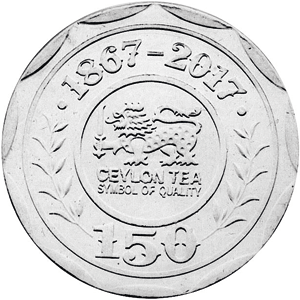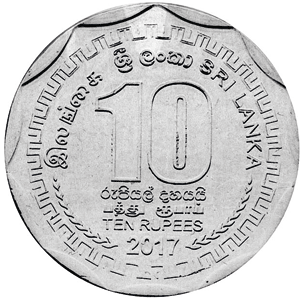Don’t confine commemorative coin for 150th anniversary of Ceylon Tea to prestige only

Obverse: Logo of the Tea 150th Anniversary with • 1867 - 2017 • on top. Wreath composed on either side of five “Two leaves and Bud” which signifies the high leaf standard that ensures the production of fine Ceylon Tea. Within plain circle Spotted Ceylon Lion standing facing left with sword in right paw.CEYLON TEA SYMBOL OF QUALITY in two lines. Below large 150 all within plain circle
On July 12, the Central Bank of Sri Lanka, issued a stainless steel Rs 10 commemorative coin for the 150th anniversary of Ceylon Tea minted at Kremnica in Slovakia to the specification of the standard Rs 10 coin in circulation since 2013.
The Lion with 17 spots is gazetted as the intellectual property of the Sri Lanka Tea Board.
The coin minted at the request of the Sri Lanka Tea Board, was issued into circulation at an event at the Central Bank, organized together with the Colombo Tea Traders’ Association. The first coin was presented by the Governor of the Central Bank Dr. Indrajit Coomaraswamy to Finance Minister Mangala Samaraweera. Plantations Minister Navin Dissanayake was also present. They all spoke of the importance of the tea industry to the economy of Sri Lanka.
The Colombo Tea Traders’ Association has taken delivery of a small fraction of these coins and hopes to package pairs of coins in small wooden boxes to be collected as souvenirs of the 150th Anniversary of Ceylon Tea.
On the day before the launch of the Tea 150th Anniversary coin I phoned the CBSL and asked if a collector could obtain some coins at the CBSL cash counter afterwards. The official informed me that since it is a coin issued at face value into circulation, they had made no provision to sell any to the public. The CBSL currency museum informed me that they had received many inquiries from the public and they may get a few coins to circulate to interested visitors to the museum. The CBSL press release was only issued after the launch and just says, “The coin will be issued into circulation from 13.07.2017 through licensed commercial banks”.
An issue of a commemorative coin should not be just for prestige, but to generate some public interest in an important event. Limited edition silver coins do not circulate and are sold for much more than face value to cover the cost of mintage. A circulation coin is therefore a good choice. Schoolchildren can then afford to collect them. However it is a pity that these commemorative coins don’t remain in circulation.

Reverse: The large numeral 10 at the centre with TEN RUPEES in Sinhala, Tamil and English below. Mint Year 2017 below text, flanked by ears of paddy on either side. SRI LANKA in Sinhala appears at the apex and Tamil and English to left and right side. A geometric design around the periphery
The CBSL Currency Museum is a great resource for collectors of coins and currency but the CBSL does not seem to see the need to run it like a Museum set up as a public relations effort. Since it opened in November 2013 there has hardly been any significant change. The Mint Currency folders on sale are still from the Mahinda Era. There is no mention that currency has been now been issued with two more pairs of signatures and will be going on to a 3rd in three years.That the Rs. 1 and Rs. 5 coins have changed in appearance or that a new series of smaller coins are expected in 2017 to reduce cost of minting them. A museum needs to be kept updated and be a source with the latest information,and to obtain the latest Coins and Currency. That will surely generate far more visitors to and serve the purpose for which it was established. I hope the administration does not see it as a venture of the older administration which does not need to be maintained.
From around 1840 to 1880 because of a dearth of small change in Ceylon, copper tokens were issued by tea and coffee mills to pay workers, who could use the tokens to buy provisions from the company shop. Some were of crude local manufacture, but many were minted in England. Most are rare, since very few were minted for internal use. After the decimal coins of 1870 went into circulation, the need for special tokens decreased. The token with a value of 4½d represented the daily wage, the price paid for picking half a hundred-weight (25.5 kg). As 240d was a Gold Sovereign which is now worth more than Rs. 48,000, the current value of 4½d is Rs. 900. Since 2016 October the daily minimum wage for picking the “norm”(16 kg) for the Estate is Rs. 805. For picking 25.5 kg they are paid Rs. 1040 which is not significantly different from the 19th Century.
A book on the History of Ceylon Tea is to be launched on July 20. The book has an image of Tea Tokens from the Lakdiva coin collection photographed by Dominic Sansoni.
(The author maintains an educational website on Lankan coins at http://coins.lakdiva.org/.)


